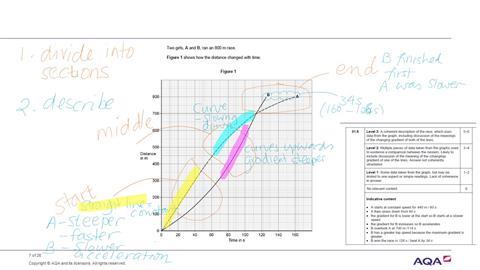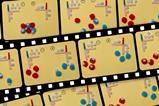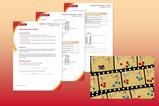Use these activity ideas and resources to keep developing your students’ key skills while not in the classroom

With students across the UK learning from home once more in 2021, many teachers are worried about the further impact on student progress. Even though exams will not happen in the normal way this year, pupils still need to continue developing skills such as interpreting graphs and writing about practicals. Below are some activities that have been successful in building certain key skills with my students, particularly when teaching remotely, and I hope you find some ideas among them that will help both you and your pupils.
Describing practical methods
Working on essential practicals remotely is complex. To combat this, I developed some resources based on ideas from Karen Knight (@KKNTeachLearn). To help students remember and understand the method of each practical, I provide a grid of hexagons for them to complete using CIDER (control, independent, dependent, equipment, risk assessment). Students then use their grids to write up a summary of the method for each practical including detail on what equipment is chosen and why. Apart from the planning tool aspect, using hexagons enables students to organise their thoughts and they can refer to their grids before attempting practice questions. This is also a suitable remote-teaching activity, done either in breakout rooms or individually before returning for feedback.
Download this
- A ready-to-use hexagon grid as MS Word or pdf for students to use to write about the methods for practicals using CIDER, along with a blank template to adapt for your own uses.
- A presentation as MS Powerpoint or pdf to introduce your students to the concept of CIDER. Either upload it to your remote learning platform or go through it in a live lesson.
I am also planning on using David Paterson’s fantastic integrated instructions resources to further help students recall steps for the practicals. I will ask pupils to write up the methods and produce flash cards to help them remember the details of what equipment should be used and why. While this is most suitable for the classroom, you could adapt it as a collaborative task for remote teaching in the form of a live discussion activity.
Interpreting graphs
Interpreting graphs is a key skill area that students struggle with. To help your students, dedicate some time during online lessons to modelling the method of:
- breaking graphs into sections (start, middle, end), perhaps using a highlighter;
- describing each section using key terminology and comparative language (eg, curve, gradient, line, increasing/decreasing, less/more steep, horizontal);
- writing explanations for each section using the relevant science knowledge (retrieval practice would work well here). To extend this, have students practise calculating gradients and using the data to justify explanations.
Try a few similar questions together and summarise the key steps before sending them off for some independent practice. This ‘I do, we do, you do’ method can be done remotely using a Powerpoint, visualiser or graphics tablet.

I did this with my class using the physics question right, asking students to describe the race depicted in the graph. In yellow, I marked out the sections (start, middle, end) and in blue I described each section using key terminology. After using this method, most of my class remembered the necessary steps for a question on terminal velocity in a recent physics test, using the skills they had developed in the analysis of velocity-time graphs.
For more tips on how to approach graphs in chemistry, check out this article by Emily Seeber and use the downloadable exercises with your students too.
Interpreting graphs is a key skill area that students struggle with. To help your students, dedicate some time during online lessons to modelling the method of:
- breaking graphs into sections (start, middle, end), perhaps using a highlighter;
- describing each section using key terminology and comparative language (eg, curve, gradient, line, increasing/decreasing, less/more steep, horizontal);
- writing explanations for each section using the relevant science knowledge (retrieval practice would work well here). To extend this, have students practise calculating gradients and using the data to justify explanations.
Try a few similar questions together and summarise the key steps before sending them off for some independent practice. and it can be done remotely using a Powerpoint, visualiser or graphics tablet.(LINK).
For more tips on how to approach graphs in chemistry, check out this article by Emily Seeber and use the downloadable exercises with your students too (LINK).
Recognising and using terminology
Simon Flynn (@flynn_simon) summarised on Twitter the idea of using ‘brain dumps’ as retrieval practice. This is an excellent technique where students are asked to write down as much as they can about a topic using as many keywords as possible and would work both as a remote teaching activity and as homework. You can also guide students to find links between topics; I have used this activity to summarise electrolysis, making links to structure and bonding, reactivity of metals and redox.
Simon Flynn (@flynn_simon) summarised on Twitter the idea of using ‘brain dumps’ as retrieval practice (LINK). This is an excellent technique where students are asked to write down as much as they can about a topic using as many keywords as possible and would work both as a remote teaching activity and as homework. You can also guide students to find links between topics; I have used this activity to summarise electrolysis, making links to structure and bonding, reactivity of metals and redox.
This is also an excellent way to then implement dual coding and Frayer models to improve students’ understanding of the terminology required to explain processes. I recently used Frayer models with my 14–15-year olds to develop their definitions for bonding. They found it challenging to think of non-examples, but using diagrams helped them to clarify ideas. They also thought that using diagrams would be useful to support written explanations. Use the resource in the downloads with your own classes, asking them to fill in the grids independently before coming back for a whole-class discussion.
Reading and understanding exam questions
Once students can recall and apply their skills, they can then focus on answering examination questions. Students often need reminding to ‘read the question’ and could use the ‘detect, recall, solve’ technique for this, which you can model in a similar way to the graph analysis mentioned above:
- Detect and highlight the command words and information in the question.
- Recall facts linked to the topic.
- Solve by responding to the commands in the questions.
Students need to check they have responded to each part of the question, tick them off, and check spellings of keywords. You can also integrate structure strips here to help.
When providing homework, give students tasks that require them to identify command words and then make summary notes and/or flash cards on the topic. Focus on misconceptions that are identified in examiners’ reports.
Download this
A slide to use with your students explaining the detect, recall, solve method, with ready-made structure strips for two example exam questions, as pdf or MS Powerpoint.
Relating knowledge to new contexts
Exams often differentiate between the best candidates by throwing in a familiar concept in a new context. (Remember the osmosis question in a recent GCSE biology exam?) Once students are confident about a topic or the steps required for an equation, it becomes easier to relate and apply their knowledge to unfamiliar contexts. That’s why it’s key to consistently build their confidence with practice and modelling.
You can still build in opportunities to think of alternative equipment, methods and chemicals while remote teaching. For example, the GCSE ‘making salts’ required practical uses copper oxide to make copper sulfate; when discussing the practical ask students, ‘What would happen if we used copper, zinc or magnesium carbonate instead? What about using a different acid?’ Do this in online class discussions or include such questions in students’ independent tasks to encourage them to think about this.
For more tips on enabling students to apply their knowledge out of context, read David Paterson’s article about tackling context in exams and Catherine Smith’s applying organic chemistry concepts to new scenarios.
For more tips on enabling students to apply their knowledge out of context, read David Patterson’s article about tackling context in exams (LINK) and Catherine Smith’sabout applying organic chemistry concepts to new scenarios (LINK).
Sue Ali
Download this
- Ready-to-use hexagon grids for students to write about RP methods using CIDER
- Frayer model grids with electrolysis diagrams (as well as blank versions to create your own)
- Presentations to explain CIDER and Detect, recall, solve to your students
All from the Education in Chemistry website: LINK.
Downloads
CIDER hexagons
Editable handout | Word, Size 0.45 mbCIDER hexagons
Handout | PDF, Size 0.12 mbKeywords for electrolysis - student worksheet
Editable handout | Word, Size 93.55 kbKeywords for electrolysis - student worksheet
Handout | PDF, Size 36.92 kbFrayer models for keywords - teacher notes
Editable handout | Word, Size 0.12 mbFrayer models for keywords - teacher notes
Handout | PDF, Size 49.54 kbDetect, recall, solve - presentation
Presentation | PowerPoint, Size 1.22 mbDetect, recall, solve - presentation
Presentation | PDF, Size 0.67 mbCIDER method - presentation
Presentation | PowerPoint, Size 2.72 mbCIDER method - presentation
Presentation | PDF, Size 0.29 mb














No comments yet